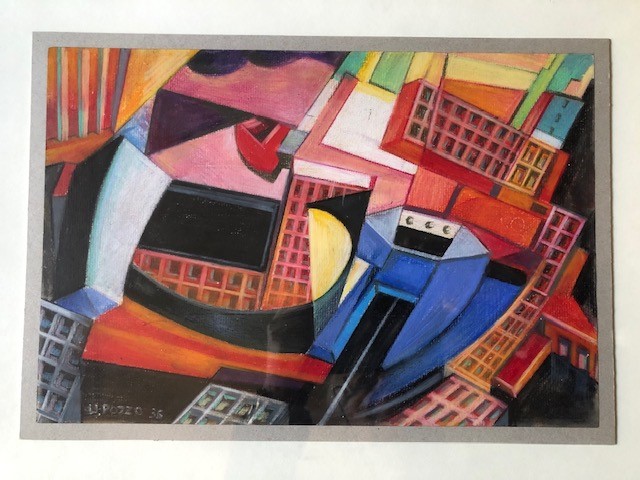Ugo Pozzo, a leader futurist, geometrical crossing buildings as in Metropolis
Prof. Francesco Carelli, University of Milan

Pozzo 36 – mixed media pastels on paper “crossing buildings
Ugo Pozzo was born in Turin on 5 July 1900. He started exhibiting his Futurist paintings from 1919 to 1921 together with Tullio Alpinolo Bracci and Luigi Colombo (Fillia). These works were exhibited almost secretly in basements, clubs and dance halls on the outskirts of town. In 1922 his paintings were displayed at the first National Caricature Exhibition in Turin’s Garden Club, along with works by other renowned caricaturists. On 5 March 1923, Pozzo founded the Turin Futurist Group with Fillia and Bracci. … In 1927, “after trying struggles and heated debates,” Pozzo and his Futurist colleagues earned a place in Turin’s Quadriennale della Promotrice which hosted the largest and most complete Futurist Art Exhibition of the period. This was the prelude to their participation in the Venice Biennale. He was famous for painting geometrical buildings verticalised all together or crossing all together as in a intertwining as we could see in movie “Metropolis”.
He was able to find an outlet for his talent through painting as well as through sculpture, caricatures, advertising and publishing graphics, interior decoration, cartoon cinema and the design and production of wooden toys. Between 1931 and 1932, Pozzo lived in Paris where, thanks to Prampolini’s assistance, he was able to work as a designer and cartoonist for Éditions Montparnasse and various newspapers.
The art critic Ezio Gianotti wrote about him :”Coadjutor of famous Fillia, than de facto his substitute in the management of the Group, Ugo Pozzo appears in the context of the values of the Futurist movement as a leading figure, with Fillia the most gifted of the group. A couple who recalls the other more famous, Boccioni – Balla, of Futurism around 1910”. In the post-World War II period, as the Futurist age was fading, Pozzo carried on developing his pictorial study through pioneering informal experiments on his own. This continued until he recaptured and redefined the personal style characterizing his Futurist works. In the 60s he resumed exhibiting his work with some regularity holding personal exhibitions in Turin, Milan, Rome, Genoa and Venice. This continued up to his death in Turin in 1981. His modest and reserved nature, the limited circulation of his works in the post-war period and some incomprehensible “oversights” by critics, have contributed to minimizing his fame, preventing him from being accurately collocated and fully recognized in the second wave of Futurism. He died in Turin, in 1981.

